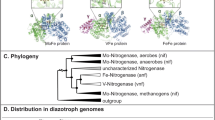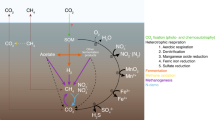Abstract
Ammonia-oxidizing bacteria (AOB) and archaea (AOA) are the main nitrifiers which are well studied in natural environments, and AOA frequently outnumber AOB by orders especially in acidic conditions, making AOA the most promising ammonia oxidizers. The phylogeny of AOA revealed in related studies, however, often varied and hardly reach a consensus on functional phylotypes. The objective of this study was to compare ammonia-oxidizing communities by amoA gene and transcript based on both genomic DNA and RNA in extremely acidic forest soils (pH <4.5). Our results support the numerical and functional dominance of AOA over AOB in acidic soils as bacterial amoA gene and transcript were both under detection limits and archaeal amoA, in contrast, were abundant and responded to the fluctuations of environmental factors. Organic matter from tree residues was proposed as the main source of microbial available nitrogen, and the potential co-precipitation of dissolved organic matter (DOM) with soluble Al3+ species in acidic soil matrix may further restrict the amount of nitrogen sources required by AOB besides NH3/NH4 + equilibrium. Although AOA were better adapted to oligotrophic environments, they were susceptible to the toxicity of exchangeable Al3+. Phylotypes affiliated to Nitrososphaera, Nitrososphaera sister group, and Nitrosotalea were detected by amoA gene and transcript. Nitrosotalea devantaerra and Nitrososphaera sister group were the major AOA. Compared to the genomic DNA data, higher relative abundances of Nitrososphaera and Nitrososphaera sister group were recognized in amoA transcript inferred AOA communities, where Nitrosotalea relative abundance was found lower, implying the functional activities of Nitrososphaera sister group and Nitrososphaera were easily underestimated and Nitrosotalea did not attribute proportionally to nitrification in extremely acidic soils. Further comparison of the different AOA community compositions and relative abundance of each phylotypes revealed by amoA genes and transcripts make it possible to identify the functional AOA species and assess their ecological role in extremely acidic soils.




Similar content being viewed by others
References
Treusch AH, Leininger S, Kletzin A, Schuster SC, Klenk HP, Schleper C (2005) Novel genes for nitrite reductase and Amo-related proteins indicate a role of uncultivated mesophilic crenarchaeota in nitrogen cycling. Environ Microbiol 7(12):1985–1995. https://doi.org/10.1111/j.1462-2920.2005.00906.x
Venter JC, Remington K, Heidelberg JF, Halpern AL, Rusch D, Eisen JA, Wu D, Paulsen I, Nelson KE, Nelson W, Fouts DE, Levy S, Knap AH, Lomas MW, Nealson K, White O, Peterson J, Hoffman J, Parsons R, Baden-Tillson H, Pfannkoch C, Rogers YH, Smith HO (2004) Environmental genome shotgun sequencing of the Sargasso Sea. Science 304(5667):66–74. https://doi.org/10.1126/science.1093857
Cao H, Hong Y, Li M, Gu JD (2011) Phylogenetic diversity and ecological pattern of ammonia-oxidizing archaea in the surface sediments of the western Pacific. Microb Ecol 62(4):813–823. https://doi.org/10.1007/s00248-011-9901-0
Cao H, Hong Y, Li M, Gu J-D (2012) Lower abundance of ammonia-oxidizing archaea than ammonia-oxidizing bacteria detected in the subsurface sediments of the Northern South China Sea. Geomicrobiol J 29(4):332–339
Beman JM, Francis CA (2006) Diversity of ammonia-oxidizing archaea and bacteria in the sediments of a hypernutrified subtropical estuary: Bahia del Tobari, Mexico. Appl Environ Microbiol 72(12):7767–7777. https://doi.org/10.1128/AEM.00946-06
Cao H, Hong Y, Li M, Gu JD (2011) Diversity and abundance of ammonia-oxidizing prokaryotes in sediments from the coastal Pearl River estuary to the South China Sea. Antonie Van Leeuwenhoek 100(4):545–556. https://doi.org/10.1007/s10482-011-9610-1
Cao H, Li M, Hong Y, Gu JD (2011) Diversity and abundance of ammonia-oxidizing archaea and bacteria in polluted mangrove sediment. Syst Appl Microbiol 34(7):513–523. https://doi.org/10.1016/j.syapm.2010.11.023
Beman JM, Roberts KJ, Wegley L, Rohwer F, Francis CA (2007) Distribution and diversity of archaeal ammonia monooxygenase genes associated with corals. Appl Environ Microbiol 73(17):5642–5647. https://doi.org/10.1128/AEM.00461-07
Steger D, Ettinger-Epstein P, Whalan S, Hentschel U, de Nys R, Wagner M, Taylor MW (2008) Diversity and mode of transmission of ammonia-oxidizing archaea in marine sponges. Environ Microbiol 10(4):1087–1094. https://doi.org/10.1111/j.1462-2920.2007.01515.x
Leininger S, Urich T, Schloter M, Schwark L, Qi J, Nicol GW, Prosser JI, Schuster SC, Schleper C (2006) Archaea predominate among ammonia-oxidizing prokaryotes in soils. Nature 442(7104):806–809. https://doi.org/10.1038/nature04983
Park HD, Wells GF, Bae H, Criddle CS, Francis CA (2006) Occurrence of ammonia-oxidizing archaea in wastewater treatment plant bioreactors. Appl Environ Microbiol 72(8):5643–5647. https://doi.org/10.1128/AEM.00402-06
Li M, Cao HL, Hong YG, Gu JD (2011) Spatial distribution and abundances of ammonia-oxidizing archaea (AOA) and ammonia-oxidizing bacteria (AOB) in mangrove sediments. Appl Microbiol Biot 89(4):1243–1254. https://doi.org/10.1007/s00253-010-2929-0
Wang YF, Gu JD (2013) Higher diversity of ammonia/ammonium-oxidizing prokaryotes in constructed freshwater wetland than natural coastal marine wetland. Appl Microbiol Biot 97(15):7015–7033. https://doi.org/10.1007/s00253-012-4430-4
Li H, Mu BZ, Jiang Y, Gu JD (2011) Production processes affected prokaryotic amoA gene abundance and distribution in high-temperature petroleum reservoirs. Geomicrobiol J 28(8):692–704. https://doi.org/10.1080/01490451.2010.514026
Weidler GW, Dornmayr-Pfaffenhuemer M, Gerbl FW, Heinen W, Stan-Lotter H (2007) Communities of archaea and bacteria in a subsurface radioactive thermal spring in the Austrian Central Alps, and evidence of ammonia-oxidizing .Crenarchaeota Appl Environ Microbiol 73(1):259–270. https://doi.org/10.1128/AEM.01570-06
Daims H, Lebedeva EV, Pjevac P, Han P, Herbold C, Albertsen M, Jehmlich N, Palatinszky M, Vierheilig J, Bulaev A, Kirkegaard RH, von Bergen M, Rattei T, Bendinger B, Nielsen PH, Wagner M (2015) Complete nitrification by Nitrospira bacteria. Nature 528(7583):504–509. https://doi.org/10.1038/nature16461
van Kessel MA, Speth DR, Albertsen M, Nielsen PH, Op den Camp HJ, Kartal B, Jetten MS, Lucker S (2015) Complete nitrification by a single microorganism. Nature 528(7583):555–559. https://doi.org/10.1038/nature16459
Palomo A, Jane Fowler S, Gulay A, Rasmussen S, Sicheritz-Ponten T, Smets BF (2016) Metagenomic analysis of rapid gravity sand filter microbial communities suggests novel physiology of Nitrospira spp. Isme J 10(11):2569–2581. https://doi.org/10.1038/ismej.2016.63
Pjevac P, Schauberger C, Poghosyan L, Herbold CW, van Kessel MA, Daebeler A, Steinberger M, Jetten MS, Lücker S, Wagner M (2016) amoA-targeted polymerase chain reaction primers for the specific detection and quantification of comammox Nitrospira in the environment. bioRxiv:096891. https://doi.org/10.1101/096891
Nicol GW, Leininger S, Schleper C, Prosser JI (2008) The influence of soil pH on the diversity, abundance and transcriptional activity of ammonia oxidizing archaea and bacteria. Environ Microbiol 10(11):2966–2978. https://doi.org/10.1111/j.1462-2920.2008.01701.x
Vonuexkull HR, Mutert E (1995) Global extent, development and economic-impact of acid soils. Plant Soil 171(1):1–15
You J, Das A, Dolan EM, Hu ZQ (2009) Ammonia-oxidizing archaea involved in nitrogen removal. Water Res 43(7):1801–1809. https://doi.org/10.1016/j.watres.2009.01.016
Zhang LM, Hu HW, Shen JP, He JZ (2012) Ammonia-oxidizing archaea have more important role than ammonia-oxidizing bacteria in ammonia oxidation of strongly acidic soils. Isme J 6(5):1032–1045. https://doi.org/10.1038/ismej.2011.168
Lehtovirta-Morley LE, Ge CR, Ross J, Yao HY, Nicol GW, Prosser JI (2014) Characterisation of terrestrial acidophilic archaeal ammonia oxidisers and their inhibition and stimulation by organic compounds FEMS. Microbiol Ecol 89(3):542–552. https://doi.org/10.1111/1574-6941.12353
Lehtovirta-Morley LE, Stoecker K, Vilcinskas A, Prosser JI, Nicol GW (2011) Cultivation of an obligate acidophilic ammonia oxidizer from a nitrifying acid soil. P Natl Acad Sci USA 108(38):15892–15897. https://doi.org/10.1073/pnas.1107196108
Pester MRT, Flechl S, Gröngröft A, Richter A, Overmann J, Reinhold-Hurek B, Loy A, Wagner M (2012) amoA-based consensus phylogeny of ammonia-oxidizing archaea and deep sequencing of amoA genes from soils of four different geographic regions. Environ Microbiol 14(2):525–539. https://doi.org/10.1111/j.1462-2920.2011.02666.x
Wu Y, Conrad R (2014) Ammonia oxidation-dependent growth of group I.1b Thaumarchaeota in acidic red soil microcosms FEMS. Microbiol Ecol 89(1):127–134. https://doi.org/10.1111/1574-6941.12340
Jung MYPS, Min D, Kim JS, Rijpstra WI, Damsté JS, Kim GJ, Madsen EL, Rhee SK (2011) Enrichment and characterization of an autotrophic ammonia-oxidizing archaeon of mesophilic crenarchaeal group I.1a from an agricultural soil. Appl Environ Microb 77(24):8635–8647. https://doi.org/10.1128/Aem.05787-11
Konneke M, Bernhard AE, de la Torre JR, Walker CB, Waterbury JB, Stahl DA (2005) Isolation of an autotrophic ammonia-oxidizing marine archaeon. Nature 437(7058):543–546. https://doi.org/10.1038/nature03911
Swift R, Sparks D (1996) Methods of soil analysis: part 3, chemical methods. Soil Science Society of America. Book Series 5:1018–1020
Nelson DW, Sommers LE (1982) Total carbon, organic carbon, and organic matter. Methods of Soil Analysis, Part 2. Chemical and Microbiological Properties. American Society of Agronomy, Madison, Wisconsin, USA, pp. 539–579
Horz HP, Barbrook A, Field CB, Bohannan BJM (2004) Ammonia-oxidizing bacteria respond to multifactorial global change. P Natl Acad Sci USA 101(42):15136–15141. https://doi.org/10.1073/pnas.0406616101
Fish JA, Chai BL, Wang Q, Sun YN, Brown CT, Tiedje JM, Cole JR (2013) FunGene: the functional gene pipeline and repository. Front Microbiol 4:291. https://doi.org/10.3389/fmicb.2013.00291
Tamura K, Stecher G, Peterson D, Filipski A, Kumar S (2013) MEGA6: molecular evolutionary genetics analysis version 6.0. Mol Biol Evol 30(12):2725–2729. https://doi.org/10.1093/molbev/mst197
Thompson JD, Higgins DG, Gibson TJ (1994) CLUSTAL W: improving the sensitivity of progressive multiple sequence alignment through sequence weighting, position-specific gap penalties and weight matrix choice. Nucleic Acids Res 22(22):4673–4680
Lehtovirta-Morley LE, Ross J, Hink L, Weber EB, Gubry-Rangin C, Thion C, Prosser JI, Nicol GW (2016) Isolation of ‘Candidatus Nitrosocosmicus franklandus’, a novel ureolytic soil archaeal ammonia oxidiser with tolerance to high ammonia concentration FEMS. Microbiol Ecol 92(5):fiw057. https://doi.org/10.1093/femsec/fiw057
He J, Shen J, Zhang L, Zhu Y, Zheng Y, Xu M, Di HJ (2007) Quantitative analyses of the abundance and composition of ammonia-oxidizing bacteria and ammonia-oxidizing archaea of a Chinese upland red soil under long-term fertilization practices. Environ Microbiol 9(9):2364–2374. https://doi.org/10.1111/j.1462-2920.2007.01358.x
Yao H, Gao Y, Nicol GW, Campbell CD, Prosser JI, Zhang L, Han W, Singh BK (2011) Links between ammonia oxidizer community structure, abundance, and nitrification potential in acidic soils. Appl Environ Microb 77(13):4618–4625. https://doi.org/10.1128/Aem.00136-11
Martens-Habbena W, Berube PM, Urakawa H, de la Torre JR, Stahl DA (2009) Ammonia oxidation kinetics determine niche separation of nitrifying archaea and bacteria. Nature 461(7266):976–U234. https://doi.org/10.1038/nature08465
Booth MS, Stark JM, Rastetter E (2005) Controls on nitrogen cycling in terrestrial ecosystems: a synthetic analysis of literature data. Ecol Monogr 75(2):139–157. https://doi.org/10.1890/04-0988
Stopnisek N, Gubry-Rangin C, Hofferle S, Nicol GW, Mandic-Mulec I, Prosser JI (2010) Thaumarchaeal ammonia oxidation in an acidic forest peat soil is not influenced by ammonium amendment. Appl Environ Microbiol 76(22):7626–7634. https://doi.org/10.1128/AEM.00595-10
Treseder KK (2008) Nitrogen additions and microbial biomass: a meta-analysis of ecosystem studies. Ecol Lett 11(10):1111–1120. https://doi.org/10.1111/j.1461-0248.2008.01230.x
Baldock JA, Skjemstad JO (2000) Role of the soil matrix and minerals in protecting natural organic materials against biological attack. Org Geochem 31(7–8):697–710. https://doi.org/10.1016/S0146-6380(00)00049-8
Scheel T, Dorfler C, Kalbitz K (2007) Precipitation of dissolved organic matter by aluminum stabilizes carbon in acidic forest soils. Soil Sci Soc Am J 71(1):64–74. https://doi.org/10.2136/sssaj2006.0111
Gubry-Rangin C, Kratsch C, Williams TA, McHardy AC, Embley TM, Prosser JI, Macqueen DJ (2015) Coupling of diversification and pH adaptation during the evolution of terrestrial Thaumarchaeota. P Natl Acad Sci USA 112(30):9370–9375. https://doi.org/10.1073/pnas.1419329112
Yin B, Crowley D, Sparovek G, De Melo WJ, Borneman J (2000) Bacterial functional redundancy along a soil reclamation gradient. Appl Environ Microb 66(10):4361–4365. https://doi.org/10.1128/Aem.66.10.4361-4365.2000
Acknowledgements
This research was financially supported by a PhD studentship from the University of Hong Kong (RW), a research grant from the National Natural Science Foundation of China [31470562] (Y-FW), and a Shenzhen Scientific Grant (JCYJ20140722112616608 to WSL) from the Shenzhen Science and Technology Innovation Committee of P.R. China.
Author information
Authors and Affiliations
Corresponding author
Ethics declarations
Funding
This study was funded by the National Natural Science Foundation of China (Grant No. 31470562 to YFW), a Shenzhen Scientific Grant (JCYJ20140722112616608 to WSL) from the Shenzhen Science and Technology Innovation Committee, and a Hong Kong PhD Fellowship (RW).
Conflict of Interest
All authors declare that they have no conflict of interest.
Ethical Approval
This article does not contain any studies with human participants or animals performed by any of the authors.
Electronic Supplementary Material
ESM 1
(PDF 75 kb)
Rights and permissions
About this article
Cite this article
Wu, RN., Meng, H., Wang, YF. et al. A More Comprehensive Community of Ammonia-Oxidizing Archaea (AOA) Revealed by Genomic DNA and RNA Analyses of amoA Gene in Subtropical Acidic Forest Soils. Microb Ecol 74, 910–922 (2017). https://doi.org/10.1007/s00248-017-1045-4
Received:
Accepted:
Published:
Issue Date:
DOI: https://doi.org/10.1007/s00248-017-1045-4




